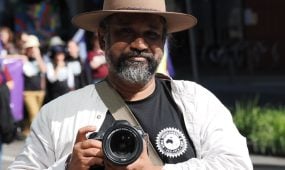The Chapel of The Holy Spirit: manifestations and mystery
Features
“The Chapel of The Holy Spirit stands proudly next to Old Bishopsbourne on the campus of St Francis College – a sacred refuge for weary locals. It is true to say that as long as Bishopsbourne has stood, there has been a chapel beside it, but there have been some changes in its location, and indeed its fabric, over the course of its long history,” says Archives Researcher Adrian Gibb
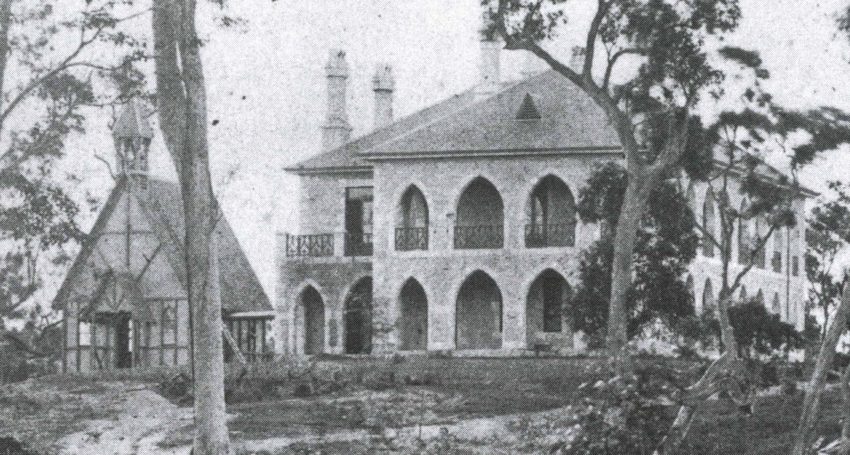
The Chapel of The Holy Spirit stands proudly next to Old Bishopsbourne on the campus of St Francis College – a sacred refuge for weary locals. It is true to say that as long as Bishopsbourne has stood, there has been a chapel beside it, but there have been some changes in its location, and indeed its fabric, over the course of its long history.
It was Bishop Tufnell, Brisbane’s first Bishop, that built the first chapel. After gaining access to 15 acres of land in the Milton area, Tufnell asked Architect Benjamin Backhouse to build ‘Bishopsbourne’ a seat for himself and, later, future Bishops and Archbishops of our Diocese. This was completed around 1866. Tufnell also requested that a simple timber chapel be erected, adjacent to Bishopsbourne, overlooking Milton Road. This was designed by Diocesan Architect Richard George Suter. By 1870 the first Bishopsbourne Chapel, not yet known as The Chapel of The Holy Spirit, was created.
Advertisement
It was this wooden chapel that first Tufnell, and then Bishop Hale, Bishop Webber, and Brisbane’s first Archbishop, St Clair Donaldson, used for their private worship. It was moved from its initial location, however, during the episcopate of Bishop Webber, who would lead the Diocese from 1885 to 1903. He decided to add a wing to Bishopsbourne which necessitated a move of the chapel to the rear of the house.
By the time Archbishop Donaldson moved into Bishopsbourne, the timber structure had fallen into disrepair, and it was decided that a new building should be erected. Archbishop Donaldson called on famed architect Robin Dods to design the new place of worship. He sought stones from the same quarry as those used in the first and second stages of the St John’s Cathedral construction. Thus, the walls of the chapel are built of Brisbane tuff (sandstone). The walls have simple buttresses supporting a roof structure of six exposed timber trusses, with the roof clad in slate. The chapel is built to a simple rectangular plan of 21 metres by 6 metres.
The chapel is lit by long, narrow Gothic-style windows in the bays between the buttresses. Unusually, the lower sections of the window openings are not glazed. To assist with air flow in our hot climate and light, they are fitted with tongue and groove timber shutters. Above the entrance is a small porch, leading to a small vestry. The floor, which is covered in red concrete, is approximately 15cm above ground level. The sanctuary is panelled in native silky oak, and the timber altar is adorned with gilded motifs of Australian flora.
On 1 June 1912, the new chapel was consecrated by Archbishop Donaldson, and dedicated with the name ‘The Chapel of The Holy Spirit’.

The July 1912 issue of The Church Chronicle, announcing the consecration of the new stone Chapel of The Holy Spirit, at Bishopsbourne (Image courtesy of the Records and Archives Centre, Anglican Church Southern Queensland)
The chapel would take on its third manifestation in 1938. Archbishop William Wand, who was enthroned in 1934, had a keen interest in the education and formation of clergy. Up until then this training had been done at the Theological College in Nundah, named ‘St Francis Theological College’ as the Parish of Nundah is dedicated to St Francis of Assisi. Archbishop Wand requested that the College be moved to Bishopsbourne, so that he might be on site and the students have better facilities. This included The Chapel of The Holy Spirit, which the Archbishop agreed to share with the formation students who all stayed on campus during their studies. As a token of delightful synchronicity, the chapel that the College had been using up until then at Nundah was donated to the parish as a parting gift. The parish moved it to Wavell Heights and created a daughter church, dedicated on 7 February 1937 by Archbishop Wand. Almost certainly in homage to the new student chapel at Bishopsbourne, it was called The Church of The Holy Spirit.
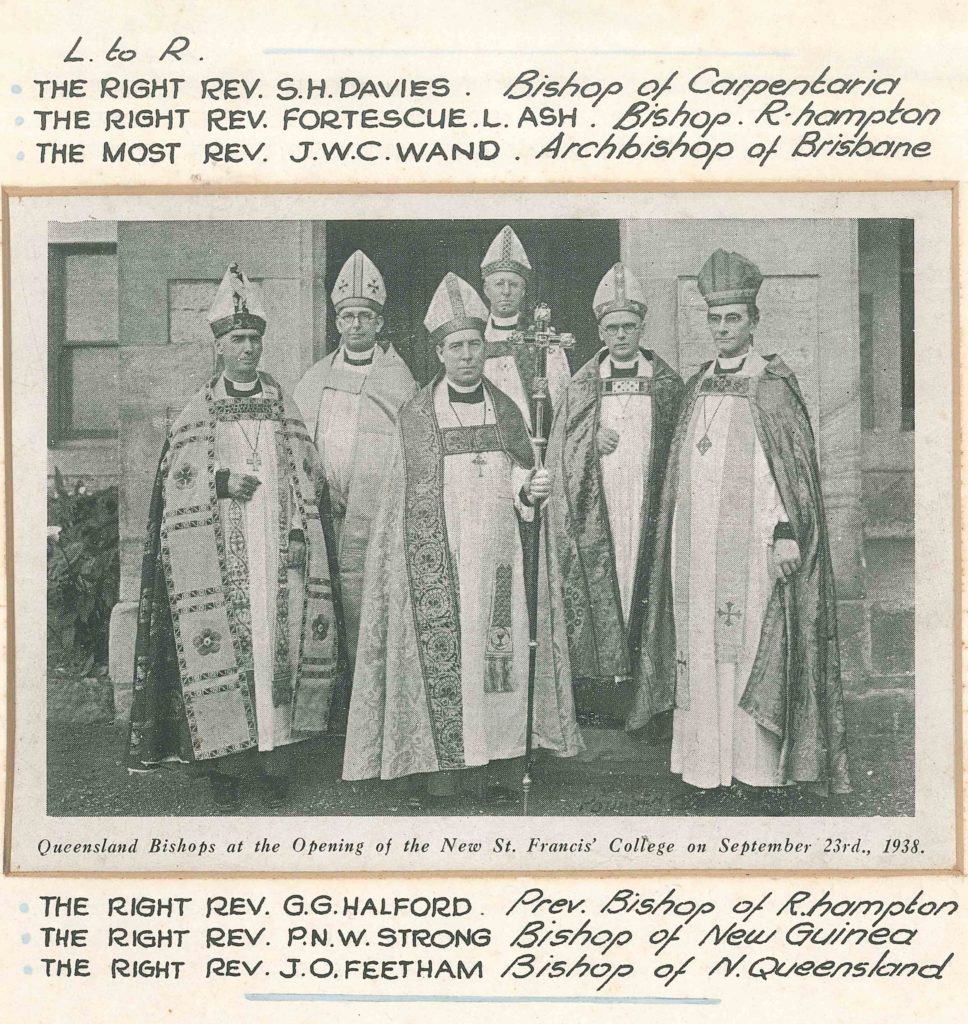
The opening of the new campus of St Francis Theological College in Milton, 1938. The students were invited to share the chapel with the Archbishop (Image courtesy of the Records and Archives Centre, Anglican Church Southern Queensland)
Within the chapel, and its surrounds, the social and spiritual fabric of our Diocese can be felt. Perhaps this is no more the case than in the triptych that can be seen above the altar in the sanctuary. It is a scene of the nativity, yet one of the shepherds, often in shadow and at the back, is more than meets the eye. Just after he became Archbishop in 1934, William Wand’s son Paul died in a mountaineering accident in Europe. In 1938, along with the arrival of the theological students, Wand asked William Bustard to create a work of art that would include an image of his son within it, commemorating him and forging an unbreakable link between the Wand family and our Diocese. Paul Wand’s image is there to this day in The Chapel of The Holy Spirit.

Close-up image of Paul Wand as a shepherd at the rear of the triptych in The Chapel of The Holy Spirit, St Francis College (Image courtesy of Eve James, Library Manager, Roscoe Library, St Francis College)
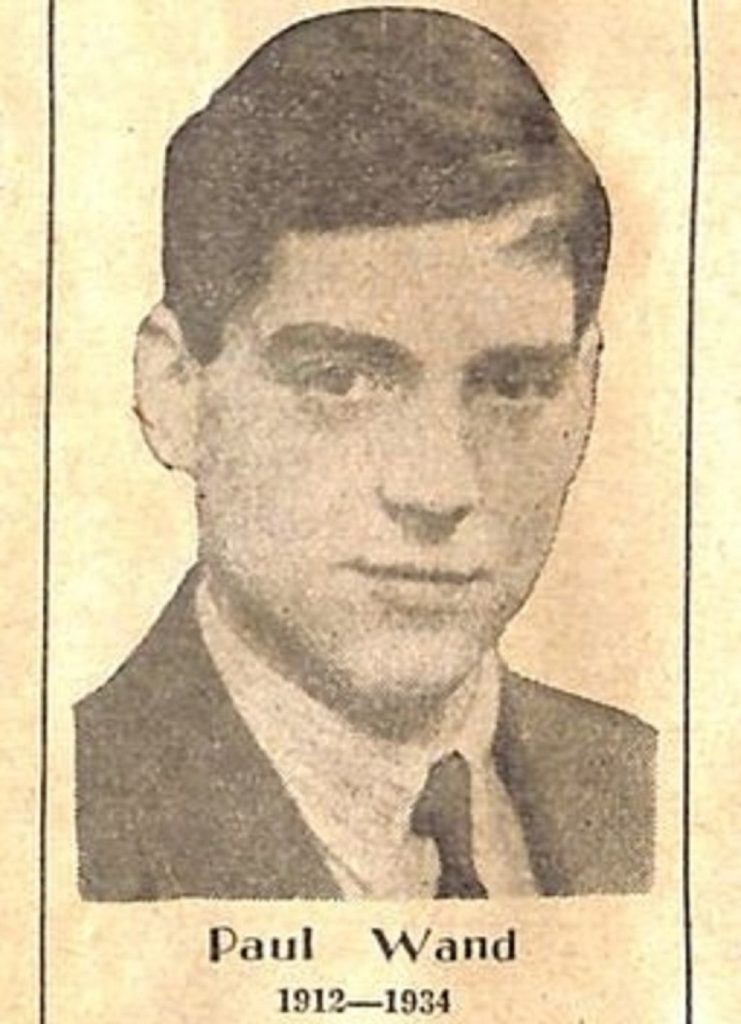
Photograph used in the tribute article Archbishop Wand wrote about his son in The Courier Mail on 6 October 1934 (Image courtesy of the Records and Archives Centre, Anglican Church Southern Queensland)
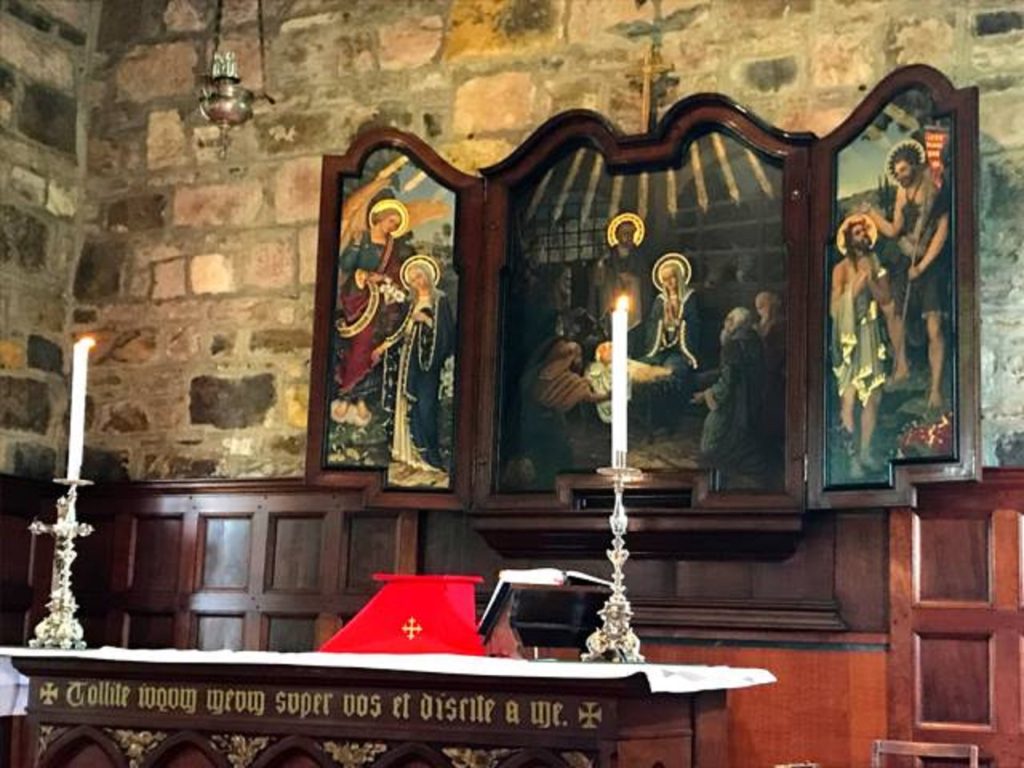
Image of the altar area at The Chapel of The Holy Spirit, St Francis College, showing the full triptych (Image courtesy of the Parish of Auchenflower-Milton)
Next to the chapel opposite the Administration building sits a small memorial cross dedicated to an Ethel Mary Light. anglican focus asked the Archives and Records Centre to research what we could about this memorial, which transpired to have, within the cross’ foundation stone, the ashes of Miss Light herself. Word had spread that Ethel Mary Light had died following a fall on a stairwell and so anglican focus asked us to find out whether this was fact or urban myth. We found no evidence to support this story, and the cause of her death remains a mystery to us. What we do know is that she died approximately one week after being admitted to a local private hospital.
Advertisement
Ethel Mary Light died in September 1943, during a transition period of our Diocese. Archbishop Wand had just resigned and returned to England, and our Diocese was being led by the Bishop Administrator, The Right Rev’d H.H. Dixon. Miss Light, as she was known, was originally from England and had come to Brisbane for the specific purpose of being the Private Secretary to Archbishop St Clair Donaldson. When Archbishop Donaldson left to return to England, Miss Light stayed and maintained her role as Private Secretary to subsequent Archbishops The Most Rev’d Gerald Sharp and The Most Rev’d William Wand.
The funeral for Miss Light was held at St John’s Cathedral on Friday 17 September 1943, before moving on to Mt Thompson Crematorium. The Diocese was keen to get into contact with Miss Light’s parents, who were in Devon, to see how best to commemorate her. Her mother sent a letter to Registrar Gordon Gall requesting that a small stone cross be erected with the following words engraved upon it:
Related Story
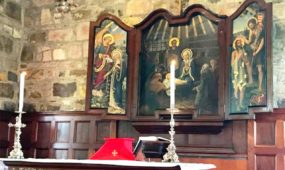 Features
Features
‘Out of the Shadow’: the love of a former Archbishop for his son
“In Cherished memory
of Ethel Mary Light
Born in London
31 May 1887
Died 16th September 1943
‘Thy Will be Done’.”
This request was made in 1945, but due to the war and lack of stonemasons, it was only in June 1946 that the cross was completed. At first this cross was going to be just a memorial stone, but the Archbishop gave consent for it to be placed next to the chapel at Bishopsbourne, where Miss Light had worked for so many years, and that her ashes be placed in the foundation stone of the cross. According to the monumental stonemason Andrew Petrie, this was indeed done, though sadly, no record of the service for the interment can be found.

Memorial cross dedicated to Ethel Mary Light

A newspaper report of the death of Miss Ethel Light, 17 September 1943 – The Courier Mail (Image courtesy of Trove)
As the years have progressed, the chapel has, quite understandably, suffered a little from the ravages of age. Earlier this year work began on some restoration projects, funded by the Community Sustainability Action (CSA) grants program, as reported in anglican focus.
There are many more conservation and restoration tasks to complete. The Chapel of The Holy Spirit, in some form, has stood on the grounds of Bishopsbourne, Milton, since 1870. Next year, 2022, will be the 110th anniversary of the construction of the existing chapel. When taking into account the services, baptisms, weddings, funerals, confirmation classes and retreat days, as well as the spiritual significance of those commemorated within it, The Chapel of The Holy Spirit stands as a jewel within our Diocese.

Work being done on The Chapel of The Holy Spirit in early 2021
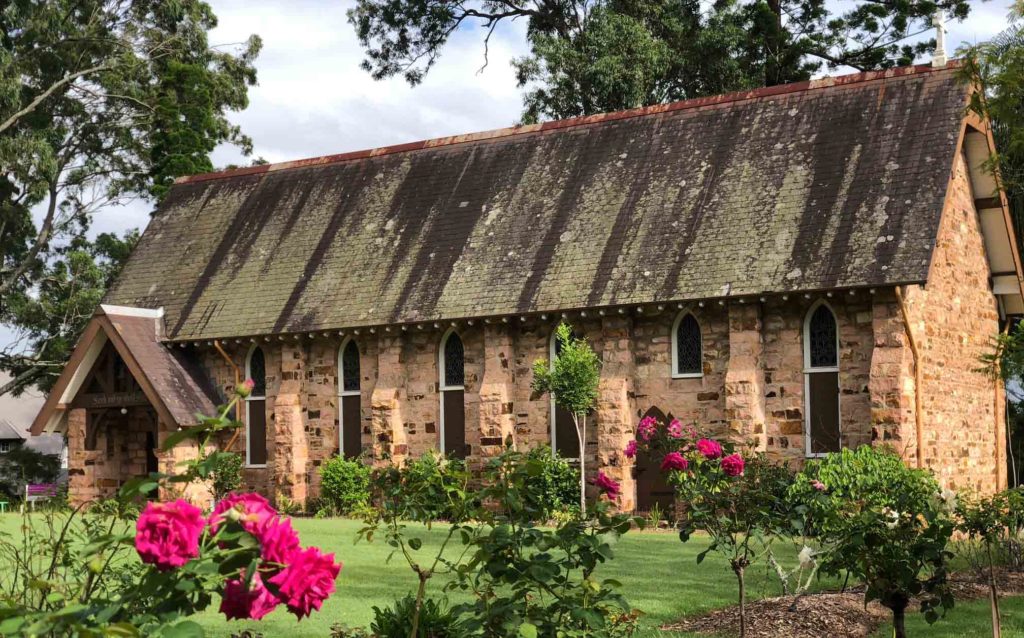
A recent image of The Chapel of The Holy Spirit (Image courtesy of brisbaneopenhouse.com.au)
Editor’s note: If you would like to make a donation to help St Francis College maintain their beautiful heritage listed buildings, you can do so easily online. Donations of $2 or more are tax deductible. If you require a tax deductible donation receipt, please email your name and address details to admin@ministryeducation.org.au.
Author’s note 27/08/2021: A reader has informed us that Ethel Mary Light passed away because of heart and respiratory issues. Thank you to the reader for sharing this information with us.


